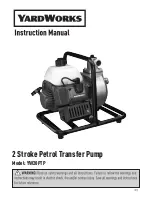
This is a publication by Conrad Electronic SE, Klaus-Conrad-Str. 1, D-92240 Hirschau (www.conrad.com). All rights in-
cluding translation reserved. Reproduction by any method, e.g. photocopy, microfilming, or the capture in electronic data
processing systems require the prior written approval by the editor. Reprinting, also in part, is prohibited. This publication
represents the technical status at the time of printing.
Copyright 2022 by Conrad Electronic SE. *2568196_v1_0922_02_dm_mh_en
• If necessary, you can also readjust the current limit or the value for the voltage control, if the
output sockets are disconnected from the mains.
• Always switch off loads and lab power supply before disconnecting the loads.
The lab power supply has a protection circuit which will limit the current in the
event of a short circuit. Always switch off the lab power supply immediately
in the event of a short circuit to avoid overheating and disconnect the loads.
Let the lab power supply cool down and make sure that the air can circulate
freely. The air outlet (13) should always be clean and dust-free; do not cover
the openings of the housing.
The maximum uninterrupted operating time of the lab power supply is 24 hours. After that
the lab power supply should be switched off until it has cooled down to ambient temperature.
Maintenance and cleaning
a) General care
• Disconnect the product from the mains socket and disconnect all connected devices before
you start cleaning it.
• The product requires no maintenance; Do not take it apart.
Live components may be exposed, if the covers are opened or parts removed (un-
less this can be done without tools).
• Do not use scouring, chemical or aggressive cleaning agents such as benzene, alcohol or
similar chemicals. These might attack the surface of the device. Furthermore, the fumes are
explosive and hazardous to your health. Moreover, you should not use sharp-edged tools,
screwdrivers or metal brushes, or the like for cleaning
• Clean the product with a soft, clean and dry cloth. Do not apply too much pressure to avoid
scratching the housing when cleaning. You can easily remove dust using a clean brush with
long, soft bristles.
b) Fuse Replacement
Switch off the lab power supply first, then remove all
connection cables from the lab power supply and re-
move the mains plug from the rear IEC connector (14).
Remove the mains plug of the lab power supply from
the mains socket.
• Remove the rear fuse holder (17) with a suitable screwdriver from
the bracket, as displayed.
• Replace the faulty fuse with a new fuse of the same type and with
the same rated current (see chapter “Technical data”).
• Squeeze the fuse cartridge carefully into the fuse holder.
• Then check that the lab power supply is working properly.
Malfunctions
The lab power supply does not work, the displays are blank.
• Check the power switch.
• Check if the IEC socket is properly connected to the power cord connector (14) at the rear
of the unit.
• Check the functionality of the mains connection (sockets, fuses, circuit breaker, etc.).
• Check that the proper mains voltage is applied.
Connected loads don’t work.
• Check polarity of the connection sockets (5 and 7).
• Check if the current limit is activated.
• Reduce the lab power supply load by removing a load.
•
Check the specifications of the loads.
Disposal
This symbol must appear on any electrical and electronic equipment placed on the
EU market. This symbol indicates that this device should not be disposed of as
unsorted municipal waste at the end of its service life.
Owners of WEEE (Waste from Electrical and Electronic Equipment) shall dispose
of it separately from unsorted municipal waste. Spent batteries and accumulators,
which are not enclosed by the WEEE, as well as lamps that can be removed from
the WEEE in a non-destructive manner, must be removed by end users from the
WEEE in a non-destructive manner before it is handed over to a collection point.
Distributors of electrical and electronic equipment are legally obliged to provide free take-back
of waste. Conrad provides the following return options
free of charge
(more details on our
website):
•
in our Conrad offices
• at the Conrad collection points
• at the collection points of public waste management authorities or the collection points set up
by manufacturers or distributors within the meaning of the ElektroG
End users are responsible for deleting personal data from the WEEE to be disposed of.
It should be noted that different obligations about the return or recycling of WEEE may apply in
countries outside of Germany.
Technical data
Operating voltage ........................................ 230 V/AC (±10%)
Frequency .................................................... 50 Hz (±2 Hz)
Control range of output voltage ................... 0 – 30 V/DC
Control range of output current .................... 0 – 10 A
Display accuracy ......................................... ±0,5% ±1 digits
Operating time without interruption .............. max. 24 h
Fuse ............................................................. 5.0 A, 250 V 5 x 25 mm
Protection class ........................................... I
Power cord length ........................................ 1.5 m
Display ......................................................... 3-digit, red LED (voltage) and red LED (current)
Operating temperature/ humidity ................. 0 bis +40 ºC, <80% rF
Storage temperature/ humidity .................... 0 bis +40 ºC, <80% rF
Dimensions (W x H x D) .............................. 226 x 82 x 138 mm
Weight ......................................................... 1.8 kg
a) Output voltage
No-load ........................................................
≤0.3 % ±100 mV
Load.............................................................
≤1 %
Residual ripple .............................................
≤200 mVp-p
b) Output current
No-load ........................................................
≤0.3 % ±100 mA
Load.............................................................
≤1 %
Residual ripple .............................................
≤200 mVp-p






























